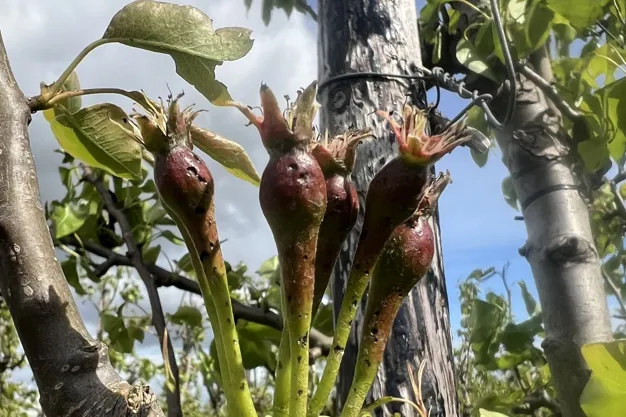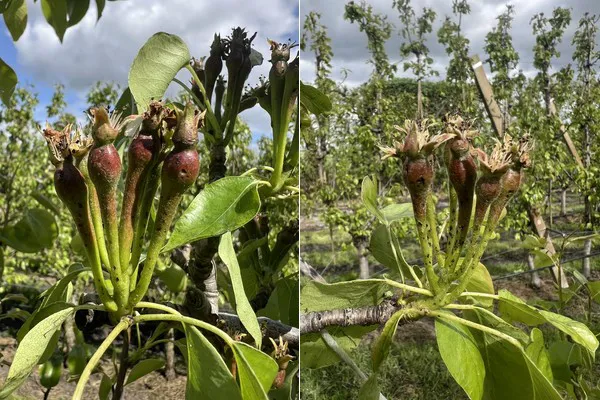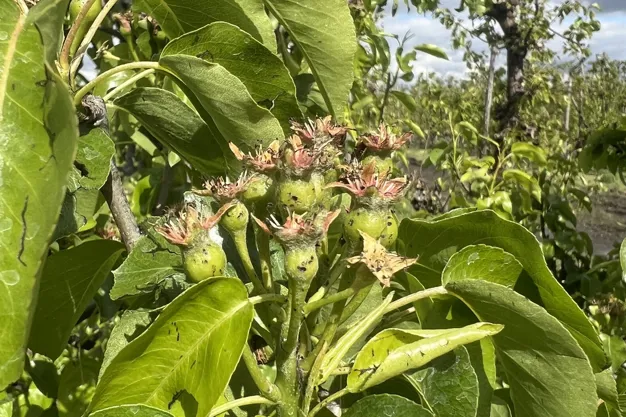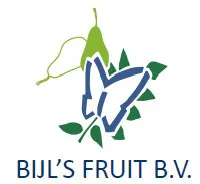Last week's hailstorm left its mark on fruit in the Netherlands. This year, pear trees, including those at Bijl's Fruit in South Holland, were in early bloom. "You work hard all year round, and in a few minutes, everything gets massively damaged. It made me sick for a few days," begins Wim Bijl.

"It's an unusually early year. Many say they didn't realize that because it hasn't been obviously warm. Though less noticeable, night temperatures have been too high. Last year, our pears were in full bloom between April 19 and 21; this year, that was as early as April 2 to 4. It varies slightly by region, but it's on average about 20 days earlier."
And the early-year hailstorm means since the pear trees had already bloomed, the fruit was hit. "We've had hailstorms before, but they're usually local. Your neighbor gets hit, and you don't, or vice versa. This cold front moved across the whole country, even as far as Belgium. It started at 2:00 PM, and at first, we thought it wasn't too bad; there was plenty of rain. The hailstones wear down slightly in the rain, becoming rounder. But in combination with the wind, those stones damaged the pears," says Wim.

Time to heal?
"From afar, the spots on the pears may look small, but get closer, and they're very obvious. The biggest disadvantage is just that so many leaves were damaged. Those are the trees' lungs. The trees need those to grow. We'll have to wait and see what the consequences will be. Conference pears could have time to recover. It sounds strange, but it was actually the best time of the year to get such a storm. Conference pears are hardier, so they can take a little more."
"But it also depends on what the weather will do in the coming period. You can compare it to a scratch on your hand. If it keeps getting dirty and wet, it won't heal. But, if the sun starts shining on it, recovery is much faster. The same applies to Conference pears. I'm somewhat less optimistic about other varieties, like Xenia, Lukassen, and Comice. Their spots will remain visible, I fear, or turn into warts. That's mainly because these varieties are more sensitive. The early bloom means the pears were already as big as on May 9 last year. All we can really do is wait and see what happens," Wim explains.

Expecting spots
He assures us that the situation is the same all over the Netherlands. "One thing is certain: there's been enormous damage in the Netherlands and Belgium. Some farms were hit harder than others, but the hail spared almost no one. We growers have plenty of contact with each other and looking at all the photos, it's a true disaster. The day after it happened, I was done. I was sick for two days. You do your very best all year, and then a few minutes can turn your whole year upside down. After a few days, you start feeling, 'Oh well, we must move on to provide people with beautiful fruit again'. What that will look like is another matter."
According to Wim, everyone should prepare for the new pear harvest to be not-so-pretty. "We have to keep going, but the trade will have to talk to the supermarkets. We can still grow delicious pears, but many will probably have spots when they reach store shelves. That means nothing; one person being slightly less good-looking than another certainly doesn't diminish their value. Nevertheless, trade and consumers must prepare for this," he says.
NFO reports millions in damages
According to data from Vereinigte Hagel and Mutual Fruit Growers Hail Insurance (OFH), last week's hailstorms caused millions of euros in damage to fruit crops. Pears were particularly hard hit. That will undoubtedly affect yield and quality, but to what extent depends on the growing season's course, reports the Dutch Fruit Growers Association (NFO).
Insurer Vereinigte Hagel received 150 claims from Dutch growers last week. They also noted 130 damage reports from Belgium. "The Dutch claims are mainly from North Holland, Flevoland, the Betuwe, and the south of the Netherlands," says Jan Schreuder of Vereinigte Hagel. "Most of the damage is in pear orchards, though we got reports from apple orchards, too. Blueberries were also hit, but the pears generally took the brunt of it. We'll be inspecting the orchards next week. But it doesn't look good; the damage will run into millions."
"We've been getting emails and phone calls all week," reports OFH's Pietjan Visser. "The damage reports come from all over the Netherlands and Belgium. Most concern pear orchards, which are currently in the crucial fruit-setting phase. With apples, there's little or no visible damage, but that may change. We also received a few reports about small fruits, mainly blueberries."
How exactly pear quality was affected remains to be seen, adds Joris Wisse, Large Fruit Cultivation Specialist at the Central Advisory Service for Fruit Cultivation. "It will remain obvious if actual bits of fruit are missing. There are orchards with fruit with multiple holes; that won't change. But how the pears will 'come out of battle' depends on the season's course. The damage will probably be more obvious if the fruits remain smooth and green than if they bronze. In short: the hailstorms will undoubtedly affect yield and quality, but to what extent remains to be seen," he concludes.
For more information:
Wim Bijl
Bijl's Fruit B.V.
10 Oosthoek
3265 LE, Piershil, The Netherlands
Tel: +31 (0) 655 904 639
Email: info@bijlsfruit.com
